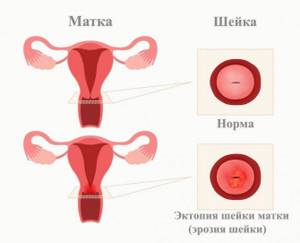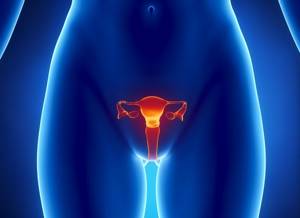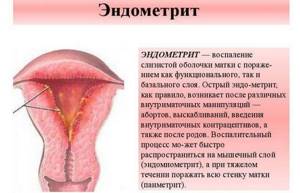Vaginal discharge from a healthy woman does not have a strong odor; red, yellow or green; impurities of blood, foam. Brown secretion is the result of hormonal imbalance, previous interventions on the organs of the genitourinary system; inflammatory, tumor or destructive processes. Brown discharge before and after menstruation, especially if it occurs regularly, is accompanied by fever, itching and pain in the lower abdomen - grounds for contacting a specialist. For a long time, a woman may not know about the presence of a disease in the organs of the reproductive, urinary, digestive or endocrine systems. The time from the development of the disease to the appearance of the first signs is from several hours (for colpitis, endometritis) to 6-9 months (for cysts, fibroids, malignant tumors). Before consulting a doctor, taking medications or heating the lower abdomen is contraindicated (even if the heat procedure seems to reduce discomfort).
Description and characteristics
Brown, odorless discharge is a general concept. This way you can describe dark yellow, brown, light and dark brown, as well as black mucus.
Its main components are the secretion produced by the glands of the reproductive system and fluid from the cervical canal. Leucorrhoea acquires an uncharacteristic color when oxidized and coagulated blood gets into it. In this case, discharge of a light or dark brown hue may not smell at all, and unpleasant sensations may not appear.
Such changes are observed during pregnancy and in different phases of the cycle. Women do not perceive them as signs of illness. There is a misconception that pathology should always be accompanied by unpleasant sensations. In fact, everything is somewhat different. There may be a hidden threat in the body that is only indicated by an uncharacteristic secretion.
Brown discharge in women: norm and pathology
The appearance of mucus with a brown tint is considered normal in the following cases:
- taking oral contraceptives;
- damage to the walls of the cervix or vagina during intimacy;
- first sex;
- brown before menstruation;
- within two days after the end of the critical days.
The occurrence of uncharacteristic secretion does not signal the development of an intimate disease. Similar symptoms appear due to hormonal changes and for a number of other reasons. If the mucus becomes abundant and heterogeneous, then this indicates the presence of disorders in women in the reproductive system.
Normally, brown liquid sometimes appears at the time of ovulation, during the implantation of the fertilized egg. The nature of the secretion is short-term and spotting.
Pathology can be suspected in the following cases:
- discharge is observed, but the woman does not take hormonal contraceptives;
- Uncharacteristic mucus is formed during menopause, when the regulation is absent for more than a year;
- brown mucus appears after each intimacy;
- there are accompanying symptoms (odor, pain, hyperthermia).
The presence of pathological secretion is a reason to visit a gynecologist. It often indicates diseases that, if not properly treated, can lead to serious consequences.
The nature of dark discharge
In women who do not have health problems, the discharge is a transudate of glands located on the vaginal wall. Under normal conditions, mucus is colorless and odorless. If it turns white and acquires a sour smell, this may indicate problems with the vaginal microflora.
If the bacterial balance is disturbed and against the background of various diseases, the color of the transudate may change. Based on the color of the discharge, doctors can roughly guess the disease that caused such changes.
Brown discharge in women very often indicates the presence of a serious pathology. However, there are conditions under which the transudate will turn brown, but this will be considered normal. We are talking about the phases of the cycle and taking certain medications.
The appearance of dark brown discharge should alert you if the following signs are revealed along with it:
- Brown discharge appears between periods.
- Dark transudate appears between menstruation, and the woman does not take medications containing hormonal components.
- The appearance of brown leucorrhoea is accompanied by the appearance of pain in the lower abdomen, lower back and sacrum.
- Leucorrhoea is accompanied by a burning sensation in the vagina.
- Sexual intercourse becomes painful.
- Rashes appear on the vaginal mucosa.
- Discharge appears during menopause.
- Discharge appears after sex.
Typically, a brown color indicates the presence of blood cells in the transudate. If bloody impurities come out outside certain phases of the cycle, then the woman should immediately contact a specialist to determine the cause of the brown discharge.
Discharge that appears at different periods of the cycle
Brown mucus appears in women at different periods of the cycle. Such changes often indicate the development of pathology, but in certain situations they are regarded as a variant of the norm.
Before your period
A few days before your period is due, a brown spot is sometimes noted. If such a symptom appears once, then there is no cause for concern. It indicates that the process of endometrial shedding has begun in the uterus.
Among the factors that can provoke prolonged brown secretion before menstruation (about a week) are:
- exposure to stress;
- improper organization of diet;
- following a strict diet;
- maintaining an unhealthy lifestyle;
- chronic lack of sleep;
- presence of bad habits;
- excessive physical stress;
- hormonal fluctuations.
The appearance of brown liquid often indicates a cycle failure and the development of pathologies. Particularly dangerous are those leucorrhoea that are accompanied by an uncharacteristic odor and pain in the lower back and abdomen.
In the middle of the cycle
Quite often, spotting appears during the period of ovulation, which occurs in the very middle of the cycle. At this moment, the fertilized egg matures and leaves the follicle. In this case, small vessels are damaged, which causes the release of blood. It gets into the secretion, oxidizes and flows out. Therefore, a brown daub is formed, with a dark or light tint.

This mucus has no odor, but can sometimes be accompanied by mild pain in the lower abdomen. These symptoms indicate a favorable period for conception.
Instead of menstruation
Dark brown, odorless discharge is sometimes observed after sexual intercourse. If such a phenomenon is observed once, then there is no cause for alarm. A spotting secretion that appears instead of menstruation should cause concern. Such changes most often indicate hormonal disorders. It is extremely important to identify their cause and eliminate it.
After menstruation
A spot with a brown tint can be observed at the beginning of the cycle - immediately after the end of the cycle. The appearance of brown discharge after menstruation is due to natural causes. The remains of blood and endometrium, which did not have time to come out during the critical days, gradually coagulate and acquire this shade. They do not cause unpleasant sensations, have no odor and disappear after a couple of days. If pain subsequently appears and the volume of discharge increases, then you should immediately be examined by a gynecologist.
A small amount of brown secretion at the end of regulation is often observed in women during the postpartum period. The walls of the reproductive organ are still stretched and weakened, which leads to the appearance of similar symptoms. As soon as the tone of the uterus returns to normal, there will be no such leucorrhoea after menstrual periods.
Causes of brown transudate
Dark discharge can appear due to normal physiological processes and various pathological conditions. For this reason, doctors divide the factors influencing the appearance of brown transudate into 2 groups: normal and pathological.
Normal Factors
Brown discharge often appears the day before menstruation begins. They always indicate that the rejection of endometrial cells has begun in the uterus. This is the norm, but only if the spotting leucorrhoea goes away within 2 days. If this does not happen, then you should consult a gynecologist.
Brown discharge can completely replace your period. This usually happens in the first month of pregnancy. In this case, the appearance of dark leucorrhoea is explained by the implantation of the embryo into the endometrium of the uterus, which provokes harmless bleeding in the middle of the cycle.
Dark transudate can also be released after menstruation. The reason for this is rapid blood clotting. At the end of the cycle, the volume of bloody discharge decreases and it moves more slowly. The blood in them has time to coagulate, which gives the discharge a specific shade.
Finally, dark leucorrhoea can be provoked by a contraceptive device such as an intrauterine device. As a rule, after its removal, the pathological signs disappear.
Pathological causes
When dark leucorrhoea persists after menstruation for a long time, then it can be considered pathological. To establish their causes, you need to go to a gynecologist and undergo a full examination.
The brown tint of the discharge indicates the presence of coagulated blood in it. This may indicate both vaginal dysbiosis and more serious diseases and pathological conditions :
- Endometritis. The disease is considered one of the most dangerous. The cause of inflammation of the endometrium is the entry of pneumococci and staphylococci into the uterus. Recognizing the appearance of pathology is not at all difficult. One of the signs of the disease is the appearance of brown discharge both before and after menstruation. Leucorrhoea is usually accompanied by mild pain, hyperthermia and sweating. If treatment is not carried out on time, a woman may develop infertility.
- Endometriosis. This is a benign tumor. The neoplasm should not be considered safe. Even at the initial stage, pathology can lead to serious consequences. The disease begins with heavy menstruation and nagging pain in the lower abdomen. Then, before menstruation, brown discharge appears, and it comes a few days before menstruation. Later, bloating is added to these symptoms.
- Polyps of the uterus and its cervix. Polyps are benign tumors. They can be localized inside the uterus or on the cervix of the organ. Polyposis does not cause any special symptoms, so the disease is detected during examination. Sometimes they can provoke the appearance of dark leucorrhoea.
- Endometrial hyperplasia and erosion of the cervical epithelium. These diseases provoke the appearance of brown spotting after menstruation. Both pathologies are very dangerous, as they can become malignant.
- Infections of the genitourinary system. Dark transudate can appear when a woman is infected with chlamydia, herpes virus, candida, gonococci, etc.
- Ectopic pregnancy. When a woman goes to the doctor with complaints of brown leucorrhoea, the doctor first does everything to make sure that this pathological condition does not exist. The fact is that an ectopic pregnancy can lead to dire consequences.
- Cystitis. With inflammation in the bladder or urethra, bleeding occurs. In this case, the woman, in addition to the pain characteristic of the disease, sees brown discharge from the urethra. Sometimes they may have red streaks.
Brownish and sometimes almost black discharge in women can also be caused by stress, lack of sleep, hormone deficiency, poor diet and bad habits.
By the way, a passion for strict diets can also cause spotting leucorrhoea to appear on a girl’s panties.
Pathological causes
Uncharacteristic discharge may occur under the influence of pathological factors. Many of them are asymptomatic, and their presence is indicated only by a smearing brown secretion. As a rule, such clinical manifestations are observed in cases of damage to the reproductive organ. They can appear before the regulation, immediately after its completion, and sometimes during other periods of the cycle.
Erosion
Ulcerations on the cervix of the reproductive organ often do not cause any symptoms. Occasionally, scanty discharge may appear after intimacy. When the scale of the lesion increases and the pathology is in an advanced stage, the mucus acquires a sharp, purulent aroma.

Endometriosis
With the development of this pathology, an abnormal growth of the functional uterine layer is noted. Due to this, blood from the reproductive organ cannot escape and begins to accumulate in the uterine cavity and genital tract. As a consequence of this, a brown spot appears at the end of menstruation.
Polyps
An abundant dark secretion that appears some time after menstruation has ended is considered a clear sign of pathology. This process can be triggered by polyps growing on the tissues of the cervix or the reproductive organ itself. In addition to scanty leucorrhea, there is often a delay in regulation. When the growth grows, pain and pus in the secretion are also observed.
Prevention and treatment
To avoid such problems, you should follow simple recommendations:
- Do not neglect the rules of intimate hygiene. You need to wash yourself twice a day and use special products rather than ordinary soap.
- During critical days, replace hygiene items every 3-4 hours.
- Do not use panty liners regularly, but only in the middle of the cycle and closer to the beginning of critical days, when the volume of secretion increases.
- Stick to a healthy diet. Reduce the consumption of unhealthy foods to a minimum and increase the amount of vegetables and fruits in the diet. The menu should be complete and balanced.
- To refuse from bad habits. Smoking and alcohol abuse have a negative impact on the reproductive system.
- Don't overexert yourself. Physical activity should be moderate.
- Maintain a daily routine. There should be enough time for sleep and rest.
- Treat any diseases in a timely manner, regardless of the nature of their occurrence.
- Regularly undergo examination by a gynecologist.
The treatment regimen largely depends on the cause of the appearance of brown discharge, which is not accompanied by an unpleasant odor or pain. If they are provoked by a hormonal disorder, then hormonal medications are prescribed. In case of development of erosion, endometriosis, the appearance of neoplasms or polyps, surgical intervention is resorted to. In the postoperative period, drug therapy is carried out aimed at the complete restoration of the reproductive system.
The reasons that provoke the appearance of brown spotting are different. Often such symptoms arise as a result of natural processes occurring in the body. Sometimes they signal the development of the disease. It is extremely important to identify it at the initial stage of development, when the only clinical manifestation of the pathology is uncharacteristic secretion. You should definitely consult your doctor. A change in the nature of the discharge may indicate serious health problems that can lead to a number of complications.
The appearance of clear, odorless discharge from the genital tract is a physiological process that occurs in almost every healthy representative of the fair sex. Depending on the period in a woman’s life, discharge may slightly change in volume and color. However, in most cases, a change in color to brown indicates the occurrence of a pathology, which necessarily requires medical intervention.
Prevention
To avoid pathological conditions in which brown discharge appears before and after menstruation, you need to follow basic preventive measures:
- carry out hygiene procedures in a timely manner and carefully
- avoid casual sex
- use condoms when having intimacy with a new sexual partner
- avoid chaotic use of oral contraceptives
- Do not lift heavy objects if you have an intrauterine device.
- refrain from sexual excesses, including rough types of intimacy
- do not use abortion as a means of birth control
- avoid intimacy during menstruation
Additional preventive measures - maintaining a distance from harmful substances or using personal protective equipment when working with them, limiting stress. If there is a hereditary predisposition to the development of cancer, a woman needs to visit a gynecologist once every six months, in other cases - once every 6-12 months. This will allow you to identify potential violations and eliminate them with minimal use of methods.
Brown discharge that appears before and after menstruation can be caused by physiological reasons, but is more often caused by disorders. Moreover, the pathogenic focus is not always associated with parts of the reproductive system. To establish the cause of the appearance of brown secretion, you need to undergo an examination, but first of all, visit a gynecologist.
Physiological conditions do not require correction, pathological conditions can be eliminated with the help of medications, physiotherapeutic procedures, subject to diet and preservation of sexual rest. The most severe diseases that cause the appearance of brown secretion from the genital tract (cancer, fibroids, polyps, cysts) are eliminated surgically. The prognosis depends on the stage of the disease at the time of visiting a doctor. Even with malignant tumors, high survival rates can be achieved if you contact specialists at the first signs of the disease.
- Lower abdomen hurts during menstruation
- Seething in the stomach
- Low prolactin
- Itchy scalp and hair loss
- Bruxism in adults
- Pain in the elbow joint of the right hand
- Chronic cystitis
- Sinus arrhythmia of the heart
- Postcoital cystitis
- Adhesions in the pelvis
- Infective endocarditis
- Lips turn blue in an adult
Discharge in healthy women
During the day, healthy representatives of the fair sex normally secrete about 1 teaspoon of mucous fluid from the genital tract. Fresh discharge is transparent, however, during the day, when it is on the laundry, it may acquire a yellowish tint and a faint sourish odor.

In some cases, brown vaginal discharge may appear. This symptom is observed:
- On the 14-15th day of the menstrual cycle, during the period of ovulation. The process of egg separation is manifested by the release of a small amount of brownish mucus with thin blood streaks.
- A few days before and within 1-3 days after menstruation. Slight brownish drops observed on underwear or pads during this period are oxidized blood.
- In the first 1-2 months of taking combined oral contraceptives. The appearance of a characteristic brown “smudge” is normal at the beginning of taking medications and indicates a restructuring and adaptation of the body to changes in hormonal levels. However, brown discharge that bothers a woman for more than 2-3 months is a reason to contact an endocrinologist and discontinue COCs.
- After using Postinor and its analogues for emergency postcoital contraception.
- After childbirth during the period of lochia separation. This clinical manifestation indicates a normal healing process of the internal membranes of the genital organs.
According to statistics, brown discharge periodically occurs in 80% of women at different periods of life, but it does not cause discomfort and even in the absence of treatment goes away without a trace.
Brown discharge without odor and accompanying discomfort should not bother a woman and be a reason for an urgent visit to the doctor. However, if you regularly detect brown, dark spotting on your underwear, accompanied by pain, fever, unpleasant odor and other pathological symptoms, it is important to undergo a full examination and start treatment in a timely manner.
Medicinal properties
For intravaginal use, Crinon is prescribed in the form of a gel.
While using the drug, the endometrial layer of the uterus is prepared for the possible onset of pregnancy, thus regulating the menstrual cycle and normalizing the woman’s hormonal levels. The use of drugs is recommended as support during IVF; it helps to relax the muscles of the uterus, thereby reducing its tone, and, consequently, the likelihood of miscarriage. Due to its gel-like structure, the drug is easy to administer and quickly produces the expected therapeutic effect.
Most common pathological causes
One of the frequent complaints with which patients turn to a gynecologist is the occurrence of bloody or brownish discharge.
Most often they are caused by processes such as:
- injuries to the internal membranes of the genital organs received during intimacy;
- improper performance of gynecological manipulations;
- use of mechanical contraception, inappropriate “aggressive” spermicides;
- violation of hormonal status;
- frequent stressful situations;
- sexually transmitted infections;
- cervical erosion;
- ovarian cysts;
- endometriosis;
- glandular hyperplasia;
- cancer of the uterus, ovaries.

Since bloody dark and light brown mucus from the vagina can be a symptom of dangerous precancerous and oncological diseases, if it is constantly discharged, it is important to consult a doctor for examination, determining the cause and prescribing the necessary treatment.
Important! Very often, brown, spotting discharge is the first sign of an ectopic pregnancy. If, against the background of a delay in menstruation, its quantity increases, pain occurs in the lower abdomen, weakness, or blood pressure drops, it is necessary to immediately call an ambulance to resolve the issue of a possible violation of the tubal pregnancy and hospitalization of the woman.
Discharge after sex
During intense sexual contact, microdamage to the mucous membranes of the vagina may occur, accompanied by the release of drops of blood, which upon contact with air acquire a frightening dark brown color. In this case you need:
- Observe the rules of personal hygiene, select suitable intimate gels, do not use soap and do not resort to douching to avoid infection of damaged mucous membranes.
- Use lubricant purchased at a pharmacy or specialty store, and be careful during intimacy.
Normally, brown discharge after sex is usually not abundant and lasts no more than two days. Their formation over a long period of time indicates serious trauma to the genital tract or the development of an infectious pathology.

Important! Brown discharge with drops of bright red blood, noted by a woman after painful sexual intercourse, indicates possible erosion of the uterine cervix.
Types of spotting after menstruation
The nature of vaginal secretion is considered to reflect the work of a woman’s reproductive organs. To detect problems in time, you need to pay attention to the color, consistency and smell of menstrual flow. It is recommended to record the results of observations in a separate notebook. This information will help the doctor make the correct diagnosis.
There are several types of spotting. Based on their shade, they are divided into the following types:
- dark;
- light brown;
- yellow-brown;
- black;
- brown.
Attention is also paid to the consistency of vaginal secretions. It may be watery, slimy, foamy, or containing clots. Normally, any inclusions in menstrual blood should be completely absent.
Brown discharge after menstruation often occurs due to severe inflammation of the uterus. Its occurrence is provoked by stagnant processes or infectious diseases. Treatment is carried out in a hospital setting. It includes the following:
- taking antibacterial agents;
- attending physiotherapeutic procedures;
- sanitation of the genital tract;
- use of antispasmodics;
- taking immunomodulators and vitamin supplements.
Attention! The inflammatory process in chronic form often becomes the cause of infertility.
Light spotting is within the normal range if it lasts no more than 2 days. It represents the remains of the endometrium formed in the previous cycle. For some women, labor discharge precedes the next menstruation. This is not considered a pathology. The light color is due to the low concentration of blood in the vaginal lubrication.
A yellowish tint to vaginal secretions appears with the development of infectious diseases that can be contracted through intimate intercourse. Their pathogens include:
- chlamydia;
- candida mushrooms;
- Trichomonas;
- gardnerella;
- papilloma virus;
- gonococci.
In order to identify pathogenic microorganisms, a smear and blood test are taken. Along with pathological spotting, severe itching, abdominal discomfort and an unpleasant odor may appear. For infectious diseases, treatment is selected depending on the pathogen. Therefore, taking medications without consulting a gynecologist is strictly prohibited.
Black discharge
A black substance is one of the many symptoms of gynecological diseases. If it appears on the last day of menstruation and does not last more than 24 hours, there is no need to sound the alarm. Blood turns dark as a result of clotting as it passes through the genital tract. In other cases, black discharge indicates the presence of the following pathologies:
- erosion;
- mycoplasmosis;
- inflammation;
- endometritis;
- polyps;
- damage to the mucosa after surgery.
An unpleasant odor is the result of the breakdown of bacterial activity. It indicates the development of infection. Brown, odorless vaginal secretion occurs with hormonal disorders, non-infectious inflammation, tumor-like formations and various damage to the reproductive organs. The occasional appearance of odorless brown daub is acceptable.
If your period ends with brown discharge accompanied by a repulsive odor, you need to sound the alarm. Such symptoms are characteristic of sexually transmitted infections. The smell can be sour, putrid or fishy. A sour smell indicates the development of candidiasis. In this case, the discharge becomes thick, similar to cottage cheese. The smell of rotten fish appears with bacterial vaginosis or trichomoniasis. A putrid aroma is characteristic of gardnerellosis.
Infectious causes
Light brown discharge often acts as one of the signs of sexually transmitted diseases. In case of viral and bacterial inflammatory processes in the genitals, the discharge that flows onto underwear or pads can be of any color. However, in the presence of inclusions of blood, which has been in contact with air for a long time, they acquire a light brown tint.
They occur when:
- Acute thrush, during which intense itching leads to self-harm during scratching. From the resulting microtraumas and cracks in the inflamed mucosa, drops of blood are released, which, when mixed with the cheesy discharge characteristic of candidiasis, give it a pink or brownish tint.
- Trichomoniasis is a sexually transmitted infectious disease that leads to dryness, burning and discomfort in the intimate area, and the appearance of copious foamy yellow, brown-orange or bloody discharge. In addition, the pathology is accompanied by dull pain in the lower abdomen, unpleasant sensations when urinating, and an unpleasant, rotten odor from the genitals.
- Gonorrhea, manifested by pain, itching, difficulty urinating, white-yellow discharge, which, with a long course of the disease, acquires a brownish tint.
Chronic pathologies
In conditions of constant stress, poor ecology, poor nutrition, bad habits, and also in cases of family history, women may experience hormonal imbalances, which, if left uncorrected, lead to dangerous pathologies.
The following diseases are most often diagnosed in patients of reproductive age:
- Endometritis is a chronic inflammation of the inner lining of the uterus. The prerequisites for the disease are intrauterine interventions, previous abortions, and miscarriages. This disease manifests itself as aching, nagging pain in the lower abdomen and back, brown discharge before and after menstruation, and cycle disruption.
- Endometriosis is a pathological condition characterized by the growth of endometrial nodules outside the uterine cavity, in the myometrium, cervical canal, ovaries, peritoneum, and bladder. The main clinical manifestations of the pathology include pain during menstruation in the abdomen, lower back, and sacrum.
- Hyperplasia is excessive growth and thickening of the inner lining of the uterus, which is benign in nature and is manifested by the appearance of brown spotting discharge, intermenstrual bleeding and heavy, prolonged periods.

In the early stages, these pathologies may not manifest themselves, but over time they lead to anemia, exhaustion of the woman, worsening hormonal imbalance and infertility. That is why it is important to regularly visit a gynecologist for preventive examinations and, if pathology is suspected, to undergo a thorough comprehensive examination. Treatment of these diseases is carried out with the help of hormonal drugs and, if necessary, surgery.
Important! In case of uterine endometrial hyperplasia, it is necessary to undergo an ultrasound of the pelvic organs and hysteroscopy with a biopsy. This will allow us to determine the nature of the overgrown tissue and prescribe the correct treatment. This disease cannot be ignored because in some cases it can lead to cancer.
Discharge after embryo transfer during IVF: physiological and pathological
The condition after IVF is a particularly strong reason for the patient to take good care of her body.
Since not only the woman’s well-being is monitored, but also the success of the procedure. All changes must be tracked.
Bloody discharge after embryo transfer
In particular, it is necessary to closely monitor the discharge after IVF transfer.
Should there be discharge after embryo transfer?
After IVF, any changes, including discharge, are a reason to pay attention to your health. Can discharge after embryo transfer be acceptable or is it always a pathology?
When embryo transfer has taken place, discharge is almost inevitable; after IVF it is a physiological reaction of the reproductive system (not only after IVF, discharge is a physiological component of the female body, depending on the cycle, external and internal factors). It is necessary to separate the norm and pathology of discharge.
Normal discharge in early pregnancy after IVF
Discharge after the replanting procedure can be justified by physiological factors: maintaining acidity and preventing drying out; reaction to taking medications: utrozhestan, progynov, kraynon; discharge during embryo implantation.
If they do not go beyond acceptable characteristics, then these are normal physiological symptoms.
On the day of the procedure:
- Transparent (colorless);
- Homogeneous consistency;
- They have no odor;
- Not abundant (scanty);
- Not causing discomfort (pain, itching, burning, etc.).
On days 6-12 they can change their characteristics, and embryo implantation occurs.
- Pale pink (optionally beige or dark cream, brownish) color, in no case bright red;
- Scanty, thick in consistency;
- Without smell;
- The period of discharge is up to two days, for a longer period this is no longer acceptable;
- There may be nagging pain in the lower abdomen;
- No discomfort.
It is worth remembering that physiological symptoms, and even more so symptoms that go beyond normal parameters, should be discussed with a doctor.
Pathological discharge after IVF
Not all symptoms (discharge) are based on physiological causes; some are an urgent reason to visit a doctor.
Discharges of a non-physiological (pathological) nature include:
- With a smell, yellow-greenish color;
- Curd-like character, with uncomfortable sensations;
- From the 12th day after embryo transfer, brown or bloody discharge occurs.
- Yellow-green discharge with an odor (there is no pulling sensation in the lower abdomen) makes it clear that there is an infection and the development of vaginosis. It is necessary to consult a doctor for treatment (no matter what stage of pregnancy it is). At the initial stage, infections are especially dangerous, as they can lead to miscarriage, infection of the fetus, or miscarriage.
- Heterogeneous discharge with a cheesy consistency combined with unpleasant sensations (itching, burning or irritation) and a sour milk smell are characteristic of vaginal candidiasis (thrush). Candidiasis is very often diagnosed in pregnant patients, including those who have undergone IVF. Exceeding the norm of hormones causes mucus with low acidity to appear in the cervical canal and the content of carbohydrates in the endometrium increases, which accordingly leads to the appearance of fungus and its further growth. Candidiasis at any stage of pregnancy, as well as vaginosis, is a reason to visit a doctor for a course of treatment (thrush can negatively affect the condition of the fetus). Self-medication is unacceptable!
- The most dangerous is brown discharge after embryo transfer and bloody discharge is just as dangerous at any stage of pregnancy after IVF. These symptoms require urgent contact with a reproductive specialist for help.
Brown discharge after eco
Brown discharge after embryo transfer can be divided into two stages. Up to 12-14 days, brown spotting after embryo transfer may indicate implantation, i.e. be completely acceptable symptoms.
The physiological reaction of the body is considered to be a small (meager) amount in the form of a daub, odorless, and may include nagging pain in the abdomen. It is normal for brown discharge to appear after transfer on days 8-9.
But brown discharge from the 14th day after embryo transfer is already a threatening signal for a pregnant woman.
Causes of brown discharge after transfer:
- Stopping the development of the embryo in the uterine cavity. The reason is a poor-quality genome;
- Insufficient hormonal support, urgent visit to a reproductologist for quick drug correction. Timely measures are the key to a successful pregnancy. One of the reasons for improper hormonal support is an independent change in medication regimen.
- Embryo rejection. Due to the high probability of uterine bleeding, surgical intervention will be required.
Bloody discharge after IVF
Immediately pay attention to spotting or bleeding. If there is a significant amount of blood - this is bleeding (especially if the color is bright red), call an ambulance, take a horizontal position and do not move until the doctors arrive.
No self-medication, strictly to the hospital. In a hospital setting, it is possible to stop the threat of miscarriage.
Bloody discharge can have different etiologies:
- Threat of miscarriage and detachment of the embryo (call an ambulance);
- The pregnancy stopped;
- Incorrect hormonal levels;
- Decreased progesterone levels (incorrect course of medication).
In any case, you need to contact a reproductologist; the diagnosis and cause will be accurately established based on ultrasound, and based on this, a course of treatment will be formed. Without an accurate diagnosis, based only on discharge, one can only assume the state of pregnancy.
: Discharge after IVF
Conclusion Carrying out the IVF procedure is a reason to treat your health even more carefully than usual. Any changes, any symptoms, even if everything seems to be within normal limits, it is better to discuss all changes with your doctor.
Normal and pathological discharge is one of the symptoms on the basis of which one cannot make a diagnosis and self-medicate.
A general examination, diagnosis, observation by a specialist will give a complete picture and on the basis of this, if necessary, adjustments will be made to maintain pregnancy, courses of treatment, competent therapy can only be prescribed by a doctor.
Source: https://detieco.ru/encyclopedia/eko-iksi/vydeleniya-posle-perenosa-yembrionov-p/
Dangerous conditions
A significant part of all gynecological diseases is occupied by tumors of the ovaries, uterus and its cervix. They can be either benign, slowly growing and not affecting other tissues, or malignant, prone to aggressive growth and metastasis.
The main danger of cancer is that it has few symptoms for a long time and practically does not bother the patient. This leads to late diagnosis of the disease, which worsens the prognosis.
The presence of a malignant tumor of the reproductive system can be suspected based on the following signs:
- Brown, spotting leucorrhoea that can occur after sex, before and after menstruation.
- Copious brownish, bloody discharge, discharge like “meat slop.”
- Constant nagging pain in the lower abdomen, perineum, lower back.
- Dysfunction of the pelvic organs (discomfort during urination, defecation).
- Unmotivated weight loss. Loss of appetite, refusal of meat food is especially common. Weakness, decreased tolerance to physical activity.
In addition to ovarian and uterine cancer, oncopathologies of the external genital organs can occur. They manifest themselves by the presence of ulcerative defects and long-term non-healing erosions, the appearance of bright red, dark brown drops on pads or underwear, thickening of the skin, dryness and itching. For tumors of the reproductive organs of any location, the patient is indicated for specific treatment by an oncologist.
Important! If any, even slight brownish discharge appears, lasting longer than 3 days, you should contact a gynecologist as soon as possible. Early detection of the disease and timely initiation of therapy are the key to good results in treatment and recovery.
In this video, a venereologist talks about brown discharge.
Vaginal secretion can indicate natural and signal pathological processes in a woman’s body, so attention is paid to it first. You can guess what brown discharge might mean based on the time of its occurrence, the duration of its course and the presence of additional symptoms.
When the symptom is within normal limits
Under certain conditions, the causes of brown discharge in women are not associated with pathology. Brownish vaginal fluid with mucus can be caused by:
- inaccurate or prolonged sexual intercourse;
- rupture of the follicular sac during ovulation;
- conception;
- beginning of pregnancy;
- postpartum recovery;
- adaptation to birth control pills;
- intense physical activity or sports;
- stabilization of the girl’s monthly cycle;
- preparing the body for menstruation;
- release of the remaining endometrium after menstruation;
- premenopause and menopause.
All these conditions have one common symptom - weak brown, moderately liquid, spotting discharge. A small stain remains on the panty liner - about 4-5 cm. The exception is the period after childbirth, when the reproductive system can secrete a larger volume of secretion. Read the article at the link about how long discharge lasts after childbirth.
If the phenomenon occurs in the middle of the cycle
During the fertile period or ovulation, blood may appear in the abundant mucous fluid of the cervical canal. At first, the vaginal secretion is transparent, but after the rupture of the follicle in which the egg matures, the mucus may darken due to the ingress of coagulated blood, acquiring a brown tint. Normally, the liquid should have the following characteristics:
- Insignificant volume.
- Smearing character.
- Light brown color of discharge (see photo).
- Duration up to two days.
- No unpleasant odor, pain or feeling of tension in the ovarian area.
Spotting Creamy discharge
It is imperative to go to the hospital if a similar situation occurs constantly, the general condition worsens, and brownish secretion appears before and after ovulation, without interruption turning into menstruation.
Before your period
A few days before monthly bleeding, a girl may notice traces of slight brown mucous discharge on her underwear or daily routine. This phenomenon is isolated. The fibrous structure of the secretion should not be scary, since this is how the body signals the beginning of the process of rejection of the mucous layer of the uterus.
Prolonged spotting of a brownish or dark burgundy hue a week before menstruation can be caused by:
- stress;
- improper diet;
- strict diets;
- overweight;
- wrong lifestyle;
- lack of sleep;
- smoking, drugs and alcohol;
- constant physical overstrain;
- severe hormone deficiency.
Cafe au lait color highlights
- 1 Color of discharge in women
- 2
- 3 Causes of discharge
- 4 Bleeding as a warning sign
- 5 What to do if 5.1 Brownish discharge bothers you 5.1.0.1 Diana: Good day! I am 27 years old, second pregnancy. At 7 weeks, brown discharge and pain in the lower abdomen appeared. I ran to the doctor - the diagnosis was “incipient miscarriage.” They sent me for an ultrasound. Ultrasound results: the uterus is displaced to the left, deviated towards the anterior; the contours are smooth; boundaries are clear; the fertilized egg is located in a typical manner; the contours are uneven along the posterior wall due to local thickening of the myometrium; boundaries are clear; branched chorion along the posterior wall; retrochorial hematoma is determined by the posterior wall of 7 mm; the length of the KTP embryo is 1.1 cm, which corresponds to 7 weeks; cardiac activity is determined. The diagnosis is a threat of interruption. Treatment: vikasol and dicenone intramuscularly, vitamin E and No-spa 3 times a day, 1 tablet. The injections have been injected for 3 days, the discharge is light (color: coffee with milk). They said they would inject me for at least three more days. Please tell me how correctly the treatment was prescribed and what are the consequences for the child from these medications?
- 5.1.0.2 Katya: Dear doctor, hello! I'm 18 weeks pregnant. Brownish discharge begins periodically. At a doctor’s appointment, where they do a quick test, each time it turns out that there is no threat, but after 2-3 weeks it smears again. Could this be a sign of something dangerous? And why is there no threat if he smears? Thank you very much for your answer!
- 5.1.0.3
3 Rhesus, antibodies
Vaginal discharge in women is a fairly common occurrence and worries every member of the fair sex from time to time. In many cases, the appearance of heavy or uncharacteristic discharge causes fear and anxiety in a woman, although in fact the appearance of discharge occurs within normal limits; the main thing is to be able to distinguish it from pathological ones.
The color of a woman's discharge can tell a lot about the state of her intimate health. If vaginal discharge is pathological, it can act as the main symptom of a large number of infectious and inflammatory diseases in the gynecological area.
Signs of pathological discharge include:
- profuse leucorrhoea;
- bloody, brown, pink, dark discharge that appears before or after menstruation;
- discharge of any color that appears before, during or after menstruation, as well as in the middle of the cycle, which is accompanied by unpleasant sensations, such as itching of the genitals, unpleasant odor, abdominal pain;
- change in the amount of normal discharge during menstruation: its sharp decrease, increase or disappearance.
The appearance of pathological discharge may be a symptom of diseases that are sexually transmitted, may indicate an inflammatory process in the female genital organs, and may also indicate the presence of tumors. If a woman is healthy, then the discharge from her vagina has a mucous consistency, is not abundant and is not accompanied by an unpleasant odor.
Color of discharge in women
Let's consider what this or that color of vaginal discharge in a woman can indicate. The norm is the appearance before ovulation of transparent, stretchy, mucous discharge similar to egg white. Mucous discharge in women is white, transparent with whitish streaks at the end of the cycle, before menstruation, indicating the presence of cervicitis, cervical erosion.
White discharge in women, with a consistency reminiscent of cottage cheese, with white films or plaque on the clitoris and between the labia minora and majora, combined with a sour milk or bread smell, can act as a symptom of thrush.
The appearance of white or slightly greenish, film-flaking discharge , usually combined with a fishy odor, indicates bacterial vaginal vaginosis (gardnerellosis).
Brown discharge in women that appears at the end of the cycle before the onset of menstruation indicates the possible presence of a pathological process in the uterus of a hormonal nature (endometriosis, polyp or endometrial hyperplasia, etc.). If the discharge appeared in the first months of taking hormonal contraceptives and lasts no more than 3 months, there is no need to worry.
Yellow discharge in women or the appearance of green bubbling discharge indicates the presence of a sexually transmitted infection (trichomoniasis, chlamydia).
Green or yellow, scanty or copious discharge indicates a bacterial infection that develops in the vagina during acute colpitis, adnexitis or salpingitis and is caused by the proliferation of opportunistic microorganisms. If the discharge is abundant, the process is in an acute stage.
Green , thick discharge that appears along with mucus, aggravated by exertion or after defecation, indicates purulent cervicitis.
Discharge in women that is pink , looks like ichor, like “meat slop” is lochia after childbirth, their appearance is considered normal if the duration does not exceed 2 months.
If such discharge is accompanied by an unpleasant odor, which usually appears before or after menstruation, this type of discharge may indicate the presence of chronic endometritis or endocervicitis.
The appearance of liquid, watery discharge after menstruation or before it, acquiring a dirty color on the pad, indicates chronic endocervicitis, chronic endometritis.
If during pregnancy liquid whitish discharge , resembling milk in appearance and intensifying as the pregnancy increases, this type of discharge is considered normal, provided that it does not irritate the external genitalia and does not have an unpleasant odor.
scarlet-colored bloody discharge a few days before the onset of menstruation indicates the presence of cervical erosion, endocervicitis. The appearance of scarlet discharge after sexual intercourse indicates cervicitis, cervical erosion, as well as the presence of microcracks in the vagina, the formation of which is associated with excessive friction during sexual intercourse.
In obstetrics there is the concept of “pregnancy norm”. These are indicators and data that are available to a healthy woman with a normal pregnancy. Light brown discharge in the early stages of pregnancy is considered normal. It is important to clarify the following circumstances:
- We are not talking about bleeding similar to menstrual bleeding.
- Bleeding of any volume (streaks, spotting, a small spot similar to menstrual bleeding) during any period is a reason to consult a doctor. Especially if it is accompanied by pain, weakness, faintness, nausea, and cramps in the lower abdomen.
A small amount of discharge in the first weeks is in most cases associated with hormonal changes, of which a lot occurs at this time:
- At 1-2 weeks of pregnancy, bleeding may occur at a time when the onset of menstruation was expected.
- In the second - third week, brownish or slightly pink mucous discharge with small reddish dots accompanies the process of implantation - the attachment of a fertilized egg in the wall of the uterus. May be accompanied by mild pain and lasts up to 5-6 days.
- At week 4, implantation bleeding can occur simultaneously with hormonal bleeding. It looks like a thick transparent substance, with small brownish areas.
- In the first weeks, discharge may be accompanied by a gynecological examination or transvaginal (through the vagina) ultrasound. As a rule, this is due either to erosion of the cervix, or to the individual sensitivity of the mucous layer of the woman’s genital organs. Due to pregnancy, this layer becomes loose, easily injured and a small amount of blood may appear. Of course, it does not look like bleeding, but several spots of light or dark red with a brown tint are quite possible.
When discharge indicates pathology
Without serious knowledge of gynecology, it is difficult to independently determine why there is brown discharge, and there is significant discomfort and pain in the lower abdomen. But a woman can pay attention to the following signs, which should prompt an immediate visit to the gynecologist:
- The bloody secretion is too thick or watery.
- The amount of fluid released increases each time.
- The gasket gets wet in less than an hour.
- Blood is noted in the mucus systematically.
- Sexual contact is accompanied by pain.
- There is a high body temperature for no reason.
- There is an unpleasant odor.
- There is itching and burning sensation.
- There are no periods for a long time.
- A large number of clots are observed during pseudomenstruation.
Often the pathological condition of the reproductive system manifests itself by the release of a large amount of secretion with blood. However, gynecological pathologies do not always make themselves felt with clear symptoms, so they can be mistakenly correlated with the consequences of stress, starvation, inaccurate coitus and other relatively harmless provocateurs. Therefore, if you detect brownish discharge of any intensity, you should visit a gynecologist. Let's consider the most common pathologies accompanied by the described symptom.
If discharge occurs instead of menstruation
This secretion may occur instead of menstruation. This is a scanty spotting secretion (up to 50 ml), which is accompanied by the following symptoms:
- lower back pain;
- feeling of tightness or pain in the chest;
- shadow the lower abdomen or suprapubic area;
- dizziness;
- nausea.
The symptom may be caused by the following reasons:
- Hormonal disbalance.
- Pituitary dysfunction.
- Endometrial injury.
- Consequence of abortion.
- Protracted inflammatory process.
- Improper functioning of the endocrine system.
- Strong physical activity.
- Exhausting sports.
- Beginning of pregnancy.
Why does the discharge change color?
The brownish color of vaginal fluid varies depending on the cause: light brown, brown, or even black. Vaginal secretion may darken due to:
- taking antibiotics;
- hormonal imbalance;
- worsening of the disease;
- development of diabetes mellitus;
- disruption of the endocrine system;
- treatment with hormones.
Remember that normal secretion, once on linen after some time under the influence of oxygen, darkens slightly, acquiring a light yellow-brown tint.
Gynecological diseases and pathologies of pregnancy
The appearance of copious dark brown discharge cannot be associated with normal processes in the body. A similar sign indicates:
- inflammatory processes;
- sexual infections;
- ectopic (ectopic pregnancy);
- threat of miscarriage (from the first to the third trimester);
- endometritis;
- cystitis;
- endometriosis;
- cervical erosion;
- polyps;
- endometrial hyperplasia;
- benign neoplasms;
- cancer.
Diseases may not be diagnosed for a long time because symptoms do not appear immediately. A woman may not be aware of the pathology and may not observe any obvious signs. The appearance of dark brown discharge often indicates an already advanced case, which will be much more difficult to treat. It is for this reason that you should visit a gynecologist every six months without a good reason, and immediately if you have unnatural symptoms.
Problems with pregnancy and malignant tumors are considered especially dangerous, because in these situations there is a threat to the patient’s life without timely treatment or surgical intervention.
Cystitis
When the urethra or bladder itself becomes inflamed, blood is released, which is not related to diseases of the reproductive system. After frequent urination, a woman not only notices bloody discharge from the urethra, but also painful sensations in the lower abdomen or lower back. Additional symptoms of urethritis resemble the common cold. The following symptoms and characteristics of the secreted fluid should alert you:
- the appearance of blood in the urine;
- frequent urge to urinate;
- cloudy urine;
- high body temperature;
- vomiting and nausea.
Infectious diseases
Infection of a woman's genital organs in the absence of timely treatment causes prolonged inflammatory processes. Such violations affect the quantity and shade of vaginal secretion. To prevent complications, women need to know the nature of dangerous brown discharge and what infections they occur with.
- chlamydia;
- gonorrhea;
- trichomoniasis;
- candidiasis (thrush);
- genital herpes;
- mycoplasmosis;
- ureaplasmosis;
- bacterial vaginosis;
- gardnerellosis.
The occurrence of these diseases can be asymptomatic until the infection provokes inflammation. Each type of pathology has its own symptoms, but in any condition, brown vaginal discharge is a serious reason to visit a doctor and take a smear for microscopic examination.
Dark discharge can be considered normal or indicate the development of a pathological process in the body. In case of any ailments, you should consult a specialist and under no circumstances self-medicate. Only based on the results of the examination and tests, the doctor will prescribe effective treatment.
“>
Discharge after IVF embryo transfer
The IVF method involves laboratory fertilization and implantation of the fetus into the uterus. The process lasts 2-5 days.
The appearance of excretion indicates the normal development of physiological processes and the development of pathologies in the body. It is important to be able to differentiate between body symptoms and determine situations when you need to worry and when not.
If the discharge after IVF is odorless, abundant and has a specific color, do not worry.
Why is embryo transfer accompanied by discharge?
Excretion is a normal condition of the female body, manifested in a regular form. With the preparation and implementation of IVF, the female body adapts to pregnancy, accompanied by a number of serious changes. Therefore, discharge of different shapes occurs.
The norm for the body is a small amount of colorless and odorless discharge. There is no increase in temperature, nagging pain or other discomfort. The reasons why discharge appeared after IVF are as follows:
- Successful IVF. Occurs when the embryo attaches to the endometrium, which partially damages it and causes discharge.
- Hormonal stimulation for fetal transfer and support.
- Signs of pregnancy.
However, in some cases pathological changes occur. They are identified by an unpleasant pungent odor, copious mucus, and additional symptoms. With such signs, immediate help is required.
Watch the video of the relationship between the endometrium and pregnancy, the causes of discharge:
Normal discharge after IVF
There are a number of types of symptoms that are considered normal, without signs of pathology. Among them are the following:
- Physiological, mucous type;
- Caused by taking hormonal drugs;
- Carrying out fetal transfer, beginning of pregnancy.
If you notice these symptoms, do not panic. They are considered normal for the female body.
See your fertility specialist’s recommendations regarding the shape of the discharge:
Discharge on the day of embryo transfer
The discharge before embryo transfer does not differ from the usual. During the process of penetration into the uterus, mucus may be released from transparent white to light pink. Discharge occurs due to damage to blood vessels, which causes the discharge to turn pink.
This process develops in 80% of women. Presence or absence is not an indicator of complications. This is a sign that IVF was successful.
At the IVF clinic on Petrovka, the procedure is carried out painlessly without the risk of infection. Specialists identify all risks in advance.
Discharge during embryo implantation
Approximately 30% of women suffer from slight bleeding during embryo transfer. Occurs from 6 to 12 after fertilization. The process can be identified by its characteristic features, namely:
| Sign | Peculiarities |
| Definition | Initially it appears as beige, pale pink, then it can become dark cream, brown discharge. |
| Form of manifestation | Not much, somewhat thick, smearing |
| Size | From a few drops to a 2-3 cm spot. |
| Duration of manifestation | Occurs within 6-12 days. Appears within 2-3 hours to a couple of days. |
| Additional features | Sometimes accompanied by various kinds of abdominal pain and swelling of the mammary gland. Without smell |
A doctor can independently determine the norm or pathology of the discharge that has arisen. If complications are suspected, it is recommended to consult a gynecologist.
Discharge after puncture
Follicular puncture is a minimally invasive operation in which several eggs are taken from the ovaries. As a result, the body receives minor trauma. Women may feel various effects that last no more than a day. Symptoms include: discharge, cramping pain.
Bloody discharge after IVF occurs due to damage to blood vessels and organs by the puncture needle. The procedure requires a lot of experience in performing otherwise there is a high risk of infection.
By contacting IVF on Petrovka, you can be confident in the quality of the puncture.
Thanks to the extensive experience of doctors, the operation is performed under a safe dose of anesthesia without the risk of inflammation of the ovaries or injuries to internal organs.
Discharge after embryo transfer
Bloody discharge after fertilization is a common occurrence. However, there are some cases indicating a failed attempt at replanting.
The following are considered pathological cases:
- Bloody. They appear within 2 weeks. Indicate serious disorders in the body;
- Brown. Indicate hormonal imbalance;
- White. There are signals for the development of candidiasis;
- Yellow-green. The cause of the development of vaginosis.
Any unusual discharge after IVF and embryo transfer requires close attention. It is important to respond to the body’s reaction in a timely manner to quickly correct the situation with the help of medications.
The effect of hormonal drugs on discharge
The entire process of fertilization is accompanied by the use of potent hormonal drugs and auxiliary supportive medications.
Progesterone gels are often prescribed; when mixed with normal secretions, they change the color of the discharge when released.
It is important to take all prescribed medications correctly and strictly as directed in order to avoid problems in the body that are not related to pregnancy. The discharge goes away quickly when you stop taking the pills or reduce the dosage.
Discharge caused by hormonal changes can be determined by the following characteristics:
| Sign | Peculiarities |
| Manifestation | Discharge of a yellow, beige, sometimes pink hue. |
| Smell | Completely absent. |
| Form of manifestation | Heterogeneous, thick. |
| Volume | From a few drops to a 2-3 cm spot. |
| Additional symptoms | They occur when taking the medication and disappear after stopping. |
Contacting the IVF clinic on Petrovka will minimize the risks of complications at any stage of pregnancy. High qualifications, experience of the entire medical team and new equipment will help identify possible pathologies and quickly eliminate them.
Types of normal discharge after IVF
The presence of discharge is considered normal. They appear throughout a woman’s reproductive life. Their character depends on the organism, accompanying factors, etc. In accordance with the state of the body, the manifestations change. A woman needs to learn to distinguish between the normal manifestations of the cycle and various pathologies.
Transparent selections
A common occurrence after the transfer of a fertilized egg is clear discharge. They are considered the norm for the female body. Necessary for maintaining microflora, mucous membranes, and acidity levels. They are determined by the following characteristics: watery, odorless or with little manifestation. Definitely homogeneous. The woman does not feel itching or burning.
Pink, creamy, light discharge after embryo transfer
During preparation for IVF and taking a number of medications, physiological mucus changes its constitution. Due to a number of factors, it becomes thicker, takes on a new shade, and slightly decreases in volume compared to before fertilization.
If the discharge began from 10 to 12 weeks, then the reason for it is bleeding caused by the introduction of the embryo. In approximately 20% of cases, this kind of manifestation is observed. They appear odorless, can be thick and smearing. Sometimes there are abdominal pains.
Spotting after embryo transfer: pale pink to dark cream
Spotting after IVF is often caused by strong drugs such as Utrozhestan, Kryon, Proginova. These medications may cause a light pink or cream-colored discharge. They appear weakly, without abundant thick mucus. The time of their manifestation coincides with the appointment. This kind of discharge goes away on its own.
With the help of modern equipment, specialists at the IVF clinic on Petrovka are able to determine the etymology of the discharge that is bothering a woman and correctly formulate emergency drug therapy when the pathology is confirmed.
Pathological discharge after IVF
In some cases, the manifestation of the following symptoms is alarming: the appearance of discharge with a specific odor, varying degrees of pain in the abdominal area, difficulty urinating. Also a number of additional signs. Such signs indicate the formation of various pathologies that require immediate assistance.
Green-yellow, cloudy discharge with an odor
A sign of stable greenish discharge indicates the progression of candidiasis, which often occurs due to the progression of bacterial microflora. Always manifests itself without pain or auxiliary symptoms.
At any stage of pregnancy, it is necessary to undergo treatment to eliminate candidiasis. Otherwise, the fetus becomes infected, fetal death or miscarriage occurs.
Watery discharge after IVF, requiring contact with IVF in Petrovka, is as follows:
| Signs | Features of manifestation |
| Form | Opaque, white, yellow and rarely green discharge |
| Smell | May present with a mild or strong unpleasant sour odor |
| Kinds | Watery, stringy or thick |
| Periods of manifestation and duration | Occurs during all periods of pregnancy. Disappears after treatment |
| Quantity | From weak to abundant according to development time |
| Nuances | Occurs without associated pain |
Curdled discharge
Bacterial candidiasis very often occurs after IVF and smears brown. This is facilitated by a high level of female hormones, supported by stimulating and hormonal therapy. The created microflora becomes a favorable environment for the development of fungal infections. Candidiasis can be identified by white, heterogeneous discharge that resembles a curd mass.
| Signs | Features of manifestation |
| Color | Opaque, white |
| Smell | Appears with a strong sour odor |
| Form | Thick, reminiscent of cottage cheese |
| Periods | Occurs during all periods of pregnancy |
| Nature of manifestation | Abundant |
| Nuances | Accompanied by itching, irritation |
Candidiasis has a significant impact on pregnancy. There is a high risk of fetal development delay and oxygen deficiency. Advanced forms lead to miscarriage, death, early birth or the birth of a child with low birth weight and other developmental delays. Treatment is allowed only under the supervision of a doctor.
Bloody, brown discharge after embryo transfer
If after IVF it smears brown, then this is the main sign of the need for immediate help. This indicates both the attachment of the embryo, but if it lasts more than two days, it indicates a cessation of development and the manifestation of negative factors contributing to the termination of pregnancy. Occurs due to internal bleeding. The reason for the appearance lies in:
- Insufficient maintenance of progesterone levels;
- Poor viability of the fetus, which developed various pathologies after administration;
- Rejection, frozen pregnancy.
You can determine which discharge is considered a pathology by the following exact signs:
| Signs | Features of manifestation |
| Color | May appear as dark brown, scarlet |
| Smell | No peculiar smell |
| Form | Liquid |
| Periods | At any stage of pregnancy |
| Quantity | Manifests itself in the form of copious discharge |
Along with the discharge, periodic nagging pain and difficulty urinating appear. If such pathologies are detected, it is necessary to urgently contact specialists.
Is it possible to prevent the appearance of discharge?
A woman is prohibited from using any medications on her own to treat or simply eliminate symptoms. Recommendation: Follow the doctor’s instructions and try to stick to your daily routine. Among the factors that help improve pregnancy experience are the following:
- Proper nutrition with the proper amount of nutrients in the diet.
- Dress warmly.
- Eliminate stress and shock.
- Regularly attend examinations and consultations.
- Try to walk outdoors every day.
- Do special exercises for pregnant women.
Timely contact with professionals will eliminate unnecessary stress and ensure a normal pregnancy. IVF Clinic on Petrovka is a leading medical center dealing with male and female infertility.
With the help of specialists, more than 2,765 pregnancies were achieved. The average experience of the entire medical team is 20 years. All work is carried out on new equipment, thanks to which great results are achieved.
Women who underwent IVF at the clinic were able to give birth without complications in 80%.
Source: https://proivf.ru/blog/vydeleniya-posle-eko/











